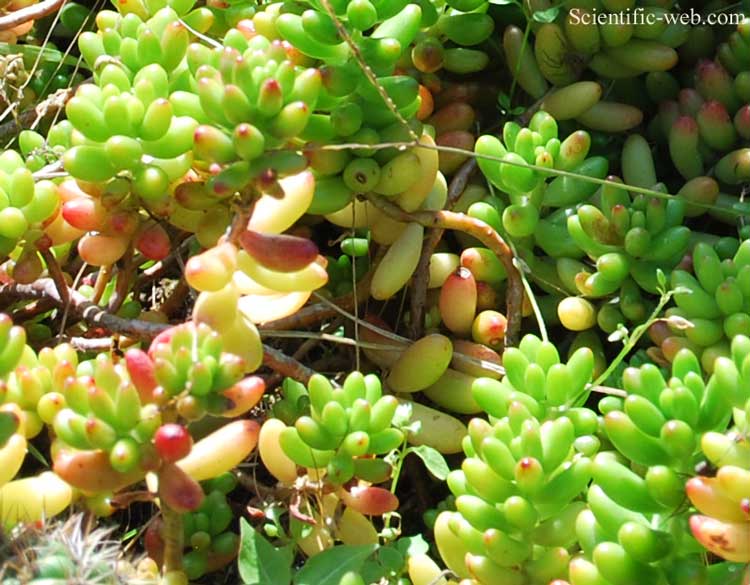
Sedum x rubrotinctum, Photo: Michael Lahanas
Classification System: APG IV
Superregnum: Eukaryota
Regnum: Plantae
Cladus: Angiosperms
Cladus: Eudicots
Cladus: Core eudicots
Ordo: Saxifragales
Familia: Crassulaceae
Subfamilia: Sempervivoideae
Tribus: Sedeae
Genus: Sedum
Sectio: Unassigned Sedum
Species: Sedum × rubrotinctum
Name
Sedum × rubrotinctum R.T.Clausen (1948)
Formula hybridae: Sedum pachyphyllum Rose × Sedum stahlii Solms
References
Clausen, R.T. (1948) Cactus and Succulent Journal (Los Angeles) 20: 82.
Uhl, C. H. (1978) Chromosomes of Mexican Sedum II. Section Pachysedum. Rhodora 80: 491–512 (503) [1].
USDA, ARS, Germplasm Resources Information Network. Sedum × rubrotinctum in the Germplasm Resources Information Network (GRIN), U.S. Department of Agriculture Agricultural Research Service. Accessed: 28-Oct-07.
Vernacular names
English: Jelly Bean Plant, Pork and Beans, Christmas cheer
עברית: צורית מאדימה
日本語: ニジノタマ
Sedum rubrotinctum or Sedum × rubrotinctum, and commonly known as jelly-beans,[1] jelly bean plant, or pork and beans. It is a species of Sedum from the plant family Crassulaceae. It is a succulent plant originating in Mexico.[2]
Name
On granite cliff
Sedum Rubrotinctum potted plant.jpg
The plant is nicknamed for its short leaves that resemble jelly beans, especially when taking on a protective hue.[3] It was named officially as a distinct species in 1948.
Description
The leaves of Sedum rubrotinctum change colour from green to red during the summer months as a protective adaptation.[3][4] The plant sprouts bright yellow flowers from between the leaves in mid-spring.[3]
Taxonomy
It has also been classified as a hybrid plant[5] — of Sedum pachyphyllum [ca; es] × Sedum stahlii [fi; sv] — named Sedum × rubrotinctum.
Cultivation
Sedum rubrotinctum is cultivated as an ornamental plant, for planting in gardens and as potted plants. It is grown very easily and tolerates all types of soil except for those that are poorly drained. It grows very well in summer, can take variations in climate, although it is not frost-tolerant.
New plants may be grown from leaves (or beans) that drop off or are separated from the stem and laid on soil.
This plant has won the Royal Horticultural Society's Award of Garden Merit.[6]
Sedum rubrotinctum is poisonous and may cause irritation when ingested or touched.[3]
References
BSBI List 2007 (xls). Botanical Society of Britain and Ireland. Archived from the original (xls) on 2015-06-26. Retrieved 2014-10-17.
"Jelly Bean – Sedum rubrotinctum – Indoor House Plants – Plant Encyclopedia Database at". Plantcare.com. 2007-10-25. Retrieved 2010-04-27.
"Sedum rubrotinctum (Pork and Beans)". Backyardgardener.com. Retrieved 2010-04-27.
"Pork and Beans (Sedum rubrotinctum)". Desert-tropicals.com. Retrieved 2010-04-27.
Sedum × rubrotinctum; R.T.Clausen (1948)
"Sedum × rubrotinctum". www.rhs.org. Royal Horticultural Society. Retrieved 5 March 2021.V
Retrieved from "http://en.wikipedia.org/"
All text is available under the terms of the GNU Free Documentation License

